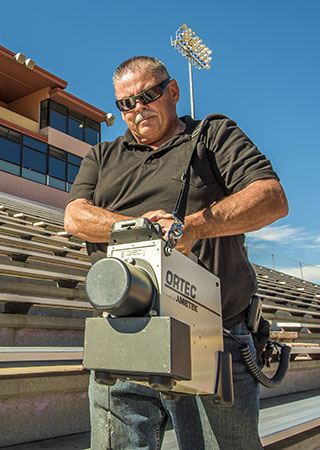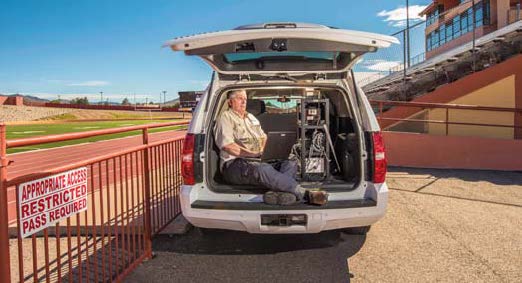Sandia RAP team works behind the scenes to protect the public at major events

Richard Stump has been to five Super Bowls, and hasn’t seen a single pass, run, or touchdown.
Richard works security — a very special kind of security — at large public events. He’s a senior scientist on Sandia’s Radiological Assistance Program (RAP) team. He, along with several other technical team members from across the Labs, make up this unique team. Sandia’s RAP team is one of several DOE/ NNSA teams throughout nine US regions.
As sentries scanning the crowd at these events, RAP provides technical expertise to respond to radiological or nuclear threats. In fact, members of Sandia’s RAP team recently supported the Republican and Democratic national conventions.
Preventive detection of radiological or nuclear materials is just part of their job. Team members also are first responders for large and small accidents involving radiological material around the Southwest and train other first responders domestically and abroad.
Preventive detection at big events
Sandia’s RAP team and partner teams at Los Alamos National Laboratory, the Waste Isolation Pilot Plant, and the Pantex Plant provide radiological detection support for large public events in Kansas, Oklahoma, Texas, New Mexico, and Arizona. They also help with major public events around the US, such as Super Bowls or visits from the pope.
Preventive radiological and nuclear detection is using the right detector systems and processes to prevent someone from using radioactive material as a weapon to hurt people or damage property, says Richard. “The last thing you want to have happen is somebody getting close enough to a stadium and manage to contaminate a lot of people. People exposed to even the smallest amount of radioactive material would be panic-stricken, even if they aren’t hurt by the initial incident.”
RAP team members can scan the crowd incognito with hand-held radiation detectors, or by circling the surrounding area with super-sensitive vehicle-mounted radiation detectors. Or they might sport nice logo hats and shirts, use traditional radiation detectors, and openly advertise their presence, depending on the threat level and desires of the event organizers.
Other events supported by the Sandia RAP team in the past include the Tucson Gem & Mineral Show, Albuquerque Balloon Fiesta, Oklahoma City Memorial Marathon, political conventions, presidential inaugurations, and many major sporting events.

RICHARD STUMP monitors a football stadium with a super-sensitive vehicle-mounted radiation detector. (Photo by Randy Montoya)
Avoiding risk of misinterpretation
“Being able to provide that layer of security for these events, and provide a level of expertise in interpreting what’s going on, is something that I have pride in. Anybody can get a radiation detector and take a measurement, but we can interpret what it means and advise on a response. Without us you would run the risk of things being misinterpreted as safe when they might not be, or vice versa,” says Hans Oldewage (6634), who recently took over for Richard as regional contractor response coordinator.
In addition to several planned events each year, RAP team members are on call as first responders to assist federal, state, tribal, and local governments for incidents involving radiological materials.
One day, they might be called out because someone finds an object with radioactive markings while cleaning out an attic; the next day they could be responding to an accident involving a vehicle transporting containers of radioactive material or safely unsticking a lethal radiation source at a national lab. Luckily, only a few of those happen each year, but they can happen at any time or anywhere in the five-state region.
“It takes a certain mindset to do emergency response and be on call 24 hours a day, seven days a week. Since you never know when you’re going to get called out, we understand if sometimes somebody can’t go. But over the years, I’ve seen people give up kids’ graduations, Christmases, and birthday parties,” Richard says. “Not once in the history of the program have we ever not been able to respond to an incident that we were called out for.”
A willingness to drop everything to respond
His teammates’ willingness to drop everything and respond fills Richard with pride. He’s quick to add that he has the same respect for firefighters, police officers, and other traditional first responders who answer emergency calls every day. Most of the members of Sandia’s 12-person RAP team are volunteers from across the Labs, including people from 1387, 4128, 4236, 6631, and 6634.
If the pager goes off, we expect them to deploy.
Richard says, “We have been so lucky at Sandia, the management from almost every organization has been more than willing to let their people volunteer and be on the team. We negotiate with their management and say ‘We need 10 percent of this person’s time who’s volunteered for the team, is that OK with you?’ That means we may call them out when they’re doing routine stuff at work, or they could be in the middle of a meeting with their management. If the pager goes off, we expect them to deploy.”
In 1994, DOE asked Sandia’s RAP team to put together a standardized weeklong training program for all RAP responders nationwide.
In the two decades since, Sandia’s RAP team, with assistance from other teams, has developed the Radiological Assistance Program Training Emergency Response (RAPTER) class and leads three or four trainings each year. The class started in Fort Chaffee, Arkansas, and later moved to Albuquerque.
Running through complex scenarios
RAPTER includes hands-on instruction on new equipment and small-scale drills. The week ends with an intense one-and-a-half day exercise where participants respond to complex scenarios throughout Albuquerque using non-hazardous materials.
A spin-off is the international RAPTER class, in which Sandia helps to train more than 1,000 first responders worldwide from China, South Africa, Djibouti, and more than 50 other countries. The training can be specialized for port and customs officials or for major public events, such as the Olympics or the World Cup.
Sandia’s RAP team also trains local and state first responders how to use radiation detectors to locate and identify sources of radiation.
Between trainings, public events, and accidents, RAP team members miss a lot of weekends at home and can be away from work and family for weeks at a time. “The biggest thrill is when you get to the end of the event and nobody was hurt. They’ve enjoyed the Super Bowl or World Series and they’re going home happy and you’re going home happy because nothing bad has happened,” says Richard. “But just the fact that we’re out there and help ensure nothing happens, that is probably the most significant high point that you get.”